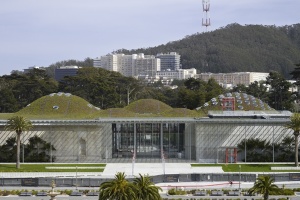Five outstanding developments � including the California Academy of Sciences in San Francisco -- have been selected as winners of the 2009 Urban Land Institute�s Global Awards for Excellence competition, widely recognized as the land use industry�s most prestigious recognition program.

The award winners, representing the world’s best cross-regional models in land use practices, were announced last week in conjunction with the ULI fall meeting in San Francisco.
The competition is part of the Institute’s Awards for Excellence program, established in 1979, which is based on ULI’s guiding principle that the achievement of excellence in land use practice should be recognized and rewarded. ULI’s Awards for Excellence recognize the full development process of a project, not just its architecture or design.
The criteria for the awards include leadership, contribution to the community, innovations, public/private partnership, environmental protection and enhancement, response to societal needs, and financial success.
The Global Awards jury panel was impressed by the innovative design of the California Academy of Sciences project, which was developed by the Academy. The project is a $488-million development that ranks as one of the world’s largest LEED-platinum public buildings. It houses an aquarium, planetarium, natural history museum, and four-story rain forest. The 412,000-sq-ft project was designed with the goal of preserving the natural habitats, species, and resources of the local environment.
“The Academy is a dramatic rebirth of a facility that had fallen into disrepair,” says Global Awards Jury Chairman Joseph E. Brown, group chief executive of AECOM in San Francisco. “It is an extraordinary green building achievement that has retained much of the old building’s qualities, while overlaying many new spatial and learning experiences.”
The decision to redevelop the facility inside Golden Gate Park, rather than move the academy offsite, helped greatly to solidify and revitalize the park, he adds, noting that an urban strategy was implemented for the benefit of both open space and cultural facilities.
The 2009 Global Awards for Excellence winners were selected from 21 worldwide finalists, all of whom were winners in their region: The Americas, EMEA and Asia Pacific. The global awards jury evaluated these projects with additional criteria, including: innovative concepts that can be emulated around the world; strong urban design; response to the surrounding environment; and design that contributes to a livable, sustainable development that demonstrates relevance to the needs of the community.
According to ULI Chief Executive Officer Patrick L. Phillips, the award winners illustrate that well-designed, well-built projects can thrive even in the most challenging of economic times. “These global winners showcase the best in creativity, innovation, and long-term thinking,” Phillips says.
The four additional 2009 Global Awards for Excellence winners are (developers in parentheses):
- American University in Cairo New Campus, Cairo, Egypt (AUC). The university’s new campus is located at the center of New Cairo City, about 40 km (20 mi) east of the current campus in downtown Cairo. It is designed to be a tool and stimulus in itself for learning and to anchor community development around the university. The 105-hectare (260-acre) virgin desert site has been developed into 200,000 square meters (2.2 million sq ft) of energy-efficient housing and academic, administrative, and student life facilities.
- The Rise, Vancouver, British Columbia, Canada (Grosvenor Americas). The Rise, a mid-rise building adjacent to a rapid transit station, successfully mixes large-format retail uses, locally-focused stores, and 92 rooftop live/work units that surround a 20,000-sq-ft green roof. The building uses one-third less energy and two-thirds less potable water than required by Canadian energy code, while the design establishes a new model of mixed-use development in Vancouver.
- West Chelsea/High Line Rezoning Plan, New York, New York (City of New York, Department of Planning). Using an innovative transfer of development rights (TDR) scheme, this plan has spurred the development of over 1,000 residential units and 2 million sq ft of commercial space in West Chelsea. The defining feature of the special district is High Line Park -- formerly an abandoned elevated rail line -- which will become a 22-block-long linear park running through the district.
- The Zhongshan Shipyard Park, Zhongshan, China (Zhongshan City, Planning Bureau). Built on a dilapidated shipyard, the Zhongshan Shipyard Park is 11 hectares of reclaimed wetlands, restored shoreline, and landscaped park space that references its industrial past with salvaged docks and machinery. The design gives much attention to restoring leftover structures, connecting with the existing urban context, and environmental responsibility.
The 2009 Global Awards for Excellence winners were selected by a jury of renowned land use development and design experts. In addition to Jury Chairman Joseph E. Brown, other members were Richard Gollis, principal, The Concord Group LLC, Newport Beach; Ian Hawksworth, managing director, Capital & Counties, London; Raj Menda, managing director, RMZ Corp, Bangalore; and Marilee Utter, president, Citiventure Associates LLC, Denver.

Post a comment to this article
Report Abusive Comment